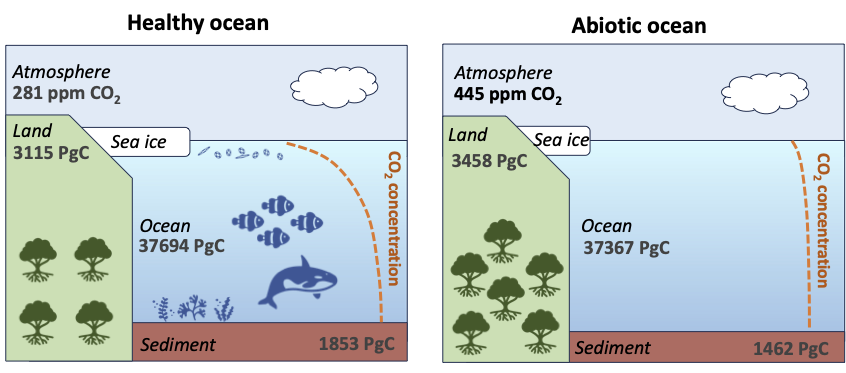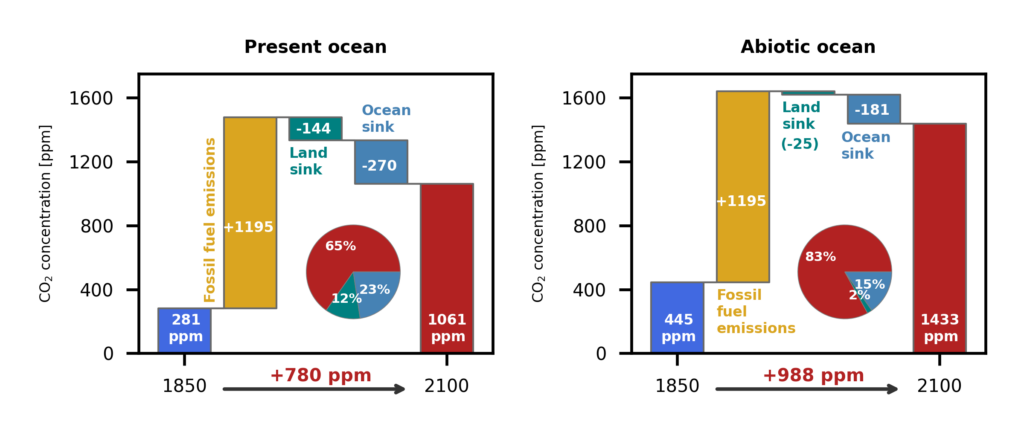The ocean plays a vital role in regulating the climate, storing roughly 50 times more carbon dioxide (CO2) than the atmosphere.
Marine life plays a significant part in this process, as organisms transfer carbon from the ocean surface to the deep sea upon death or as they migrate.
Our new research, published in Nature Communications, suggests the contribution of ocean biology to climate regulation is more complex than previously thought.
To explore how ocean biology shapes the past, present and future climate, we explore an extreme scenario where all marine life has been wiped out.
We find that – in a pre-industrial climate – CO2 levels would rise by 50% without marine life, leading to 1.6C of global warming.
In a separate study in Nature Climate Change, we estimate that ocean biology sequesters the equivalent of 10bn tonnes of CO2 each year.
This is more than one quarter of annual fossil-fuel emissions from human activity.
We also calculate that the contribution of marine life to carbon storage is worth hundreds of billions of dollars each year.
Biological carbon pump
The ocean takes up and stores vast amounts of CO2 every year through two mechanisms known as “carbon pumps”.
The first is the “solubility pump”. This is the process by which dissolved CO2 in seawater is transported from the ocean’s surface to its depth through the sinking and upwelling of water mass.
The second is the “biological carbon pump”. This is the process where carbon is converted into organic materials by plankton and other marine organisms at the ocean’s surface and then transported to the deep sea when they die or migrate.
Scientists have long known that the biological carbon pump played an essential role in maintaining low atmospheric CO2 levels before the industrial revolution.
However, the conventional view is that the solubility pump has been responsible for the ocean’s steady absorption of rising CO2 emissions caused by human activity.
Our findings challenge this view, by showing the biological carbon pump plays a crucial role in the modern ocean’s sequestration of atmospheric CO2.
We find that, without marine life, the ocean’s capacity to capture CO2 emissions would be significantly diminished.
Two scenarios
To get an estimate of the contribution of the marine carbon pump in a stable pre-industrial climate, we simulate the planet’s climate as it was before the industrial era using a complex Earth system model.
(This is the second generation of the Norwegian Earth system model, which contributed to the sixth Coupled Model Intercomparison Project.)
We then explore what would happen to the Earth’s climate system under two scenarios:
- A reference, “healthy ocean” scenario where ocean biology conditions were as realistic as possible.
- An “abiotic” scenario where all marine life is removed.
In a pre-industrial scenario with no marine life, we find that atmospheric CO2 levels would rise to 445 parts per million (ppm). This is an increase of more than 50% on the “healthy ocean” scenario, where CO2 levels are 282ppm.
(This suggests that the influence of marine life on global CO2 levels is greater than the sum of all human activity, which has – so far – raised atmospheric CO2 concentrations to around 425ppm).
The rise in CO2 levels caused by the absence of marine life would result in about 1.64C of global warming at the surface and a 1.15C increase in global sea surface temperature.
This warming would have considerable impacts on the wider world, including declines in sea ice area at the Arctic and Antarctic of close to 25% and an Atlantic Meridional Overturning Circulation that was around 9% weaker.
The value of exploring such an extreme scenario is to investigate the role biological processes in the ocean play in carbon storage, as well as the implications of damage to marine life.
The role of terrestrial ecosystems
Our estimation that pre-industrial atmospheric CO2 would rise by 163ppm without ocean biology is on the lower end of the 150-240ppm range approximated by some previous studies.
However, previous estimates of the contribution of the biological carbon pump in a pre-industrial climate neglect the interactions between oceanic and terrestrial biospheres.
Our research reveals that terrestrial ecosystems – such as tropical forests and grasslands – play a crucial role in compensating for the increase in CO2 concentrations when ocean life declines. (This is due to the CO2 fertilisation effect, when higher CO2 concentrations speed up photosynthesis).
We find that in the extreme pre-industrial scenario, approximately half the carbon lost from the ocean is absorbed by the land.
The figure below illustrates the Earth’s carbon reservoirs in a pre-industrial climate with (left) and without (right) marine life. It shows how, if marine life is wiped out, carbon content decreases in the ocean and marine sediment, whereas more carbon accumulates in the atmosphere and on land.

Ramifications for the future
Today, the ocean captures approximately 25% of human-caused CO2 emissions – which allows it to play a crucial role in slowing global warming.
In order to estimate the overall importance of marine life to carbon sequestration in the ocean, we also conduct experiments for various future emission pathways – both with, and without, marine life.
In all cases, we find that more CO2 emitted by human activities remains in the atmosphere when there is no marine life.
One might think that the ocean’s lower concentrations of carbon in the pre-industrial climate, relative to the atmosphere, might mean it would be able to absorb more additional carbon.
However, we find the absence of marine life fundamentally alters the vertical distribution of carbon in the ocean. Although the total amount of carbon stored is lower, there is more carbon at the surface due to an absence of organisms. This, in turn, hinders additional CO2 from entering the ocean.
Another surprising finding of the simulations was that the terrestrial biosphere’s capacity to absorb excess CO2 by increasing its vegetation mass diminishes over time, potentially due to limited nutrients.
The figure below shows the distribution of the human-caused CO2 in the Earth’s carbon reservoirs under two 2100 scenarios. The chart on the left shows a scenario with ocean life, and the chart on the right shows one without ocean biology.
It illustrates how, without marine life, more CO2 stays in the atmosphere and less goes into the land and the ocean.

The study shows that in the absence of marine life, future warming would occur faster and more intensely.
This acceleration in warming would potentially trigger other processes that could further amplify warming, such as greater ocean stratification, longer sea-ice free Arctic summers and greater loss of permafrost.
Economic benefits
Damaging marine life is economically costly given the many and various benefits – or “ecosystem services” – provided by carbon sequestration.
We estimate that the sinking of organic matter sequesters approximately 2.8bn tonnes of carbon annually, locking it away from the atmosphere for at least 50 years.
This carbon sequestration capacity is equivalent to 10bn tonnes of atmospheric CO2 – or roughly 27% of emissions generated by fossil fuels in 2024.
We estimate – based on a carbon price of $90 per tonne of CO2 – that the carbon storage provided by the marine carbon pump is worth $545bn per year in international waters and $383bn per year within national waters. Its total value is projected to exceed $2.2tn by 2030.
Carbon storage is valuable because it helps avoid climate impacts.
This economic value is important for developing countries, particularly small island developing states whose national waters are collectively responsible for 11% of biological carbon pump sequestration activity, in terms of carbon stored.
The top eight countries where the biological carbon pump value is highest in proportion to gross domestic product (GDP) are small island states. These are the Cook Islands, Kiribati, the Marshall Islands, Micronesia, Nauru, Niue, Palau and Tuvalu. Of these nations, just one – the Cook Islands – is classified by the World Bank as high income.
These climate-impacted nations’ key role in preserving ocean health should be considered in discussions of international climate finance.
The figure below shows the economic value of carbon sequestration of the biological carbon pump for each of these eight small island states, calculated on the basis of a carbon price of $90 per tonne of CO2.
For example, it illustrates how Micronesia and Kiribati have an estimated biological carbon pump value of $4,620m and $8,525m each year, respectively.

A healthy ocean buys the world time in the battle against global warming, but the window to protect it is closing rapidly.
Marine ecosystems remain vulnerable to a raft of human activities, including industrial fishing, pollution, shipping and deep-sea mining. Stronger conservation policies, enhanced financial incentives for lower income countries and increased international cooperation are essential to protect the services provided by ecosystems.
These are important steps towards not only protecting 30% of the global ocean as agreed under the new Global Biodiversity Framework – but it will help to reach the Paris Agreement’s climate target.
There are a number of tools at governments disposal to protect the valuable services provided by marine ecosystems. This includes promoting sustainable fishing and ecotourism, establishing marine protected areas and undertaking robust environmental impact assessments.
Nations can also support protection of the biological heat pump within international waters by ratifying the High Seas Treaty, which recognises the importance of protecting biogeochemical cycles.
The post Guest post: How marine life provides climate benefits worth billions of dollars appeared first on Carbon Brief.
Guest post: How marine life provides climate benefits worth billions of dollars
Greenhouse Gases
DeBriefed 28 November 2025: COP30’s ‘frustrating’ end; Asia floods; UK ‘emergency’ climate event
Welcome to Carbon Brief’s DeBriefed.
An essential guide to the week’s key developments relating to climate change.
This week
‘Lukewarm’ end to COP30
BYE BELÉM: The COP30 climate talks in Belém ended last weekend with countries agreeing on a goal to “triple” adaptation finance by 2035 and efforts to “strengthen” climate plans, Climate Home News reported. The final deal “fell short on the global transition away from oil, gas and coal”, the outlet said, as Brazil announced that it would bring forward voluntary roadmaps to phase out fossil fuels and deforestation, before the next COP. It was a “frustrating end” for more than 80 countries who wanted a roadmap away from fossil fuels to be part of the formal COP agreement, BBC News said.
WHAT HAPPENED?: Carbon Brief published its in-depth analysis of all the key outcomes from COP30, spanning everything from negotiations on adaptation, just transition, gender and “Article 6” carbon trading through to a round-up of pledges on various issues. Another Carbon Brief article summed up outcomes around food, forests, land and nature. Also, Carbon Brief journalists discussed the COP in a webinar held earlier this week.
ART OF THE DEAL: The “compromise” COP30 deal – known as the “global mutirão” – “exposed deep rifts over how future climate action should be pursued”, Reuters noted. The “last-ditch” agreement was reached after fossil-fuel wording negotiations between the EU and Saudi Arabia, according to the Guardian. Meanwhile, Carbon Brief revealed the “informal” list of 84 countries said to have “opposed” the inclusion of a fossil-fuel roadmap in the mutirão decision, but analysis of the list exposed contradictions and likely errors.
UNITY, SCIENCE, SENSE: The final agreement received “lukewarm praise”, said the Associated Press. Palau ambassador Ilana Seid, who chaired the coalition of small-island nations, told the newswire: “Given the circumstances of geopolitics today, we’re actually quite pleased…The alternative is that we don’t get a decision and that would have been [worse].” UN climate chief Simon Stiell said that amid “denial, division and geopolitics”, countries “chose unity, science and economic common sense”, reported the Press Trust of India.
Around the world
- Floods and landslides killed more than 200 people in Thailand and Indonesia this week, reported Bloomberg. At least 90 people also died in recent floods in Vietnam, said Al Jazeera.
- New measures to cut energy bills and a “pay-per-mile” electric-vehicle levy were among the announcements in the UK’s budget, said Carbon Brief.
- The Group of 20 (G20) leaders signed off on a declaration “addressing the climate crisis” and other issues, reported Reuters, which had no input from the US who boycotted last week’s G20 summit in South Africa.
- Canadian prime minister Mark Carney signed a deal with the province of Alberta “centred on plans for a new heavy oil pipeline”, said the Guardian, adding that Canadian culture minister and former environment minister, Steven Guilbeault, resigned from cabinet over the deal.
- Greenpeace analysis, covered by Reuters, found that permits for new coal plants in China are “on track to fall to a four-year low” in 2025.
27
The number of hours that COP30 talks went over schedule before ending in Belém last Saturday, making it the 11th-longest UN climate summit on record, according to analysis by Carbon Brief.
Latest climate research
- The risk of night-time deaths during heatwaves increased “significantly” over 2005-15 in sub-Saharan Africa | Science Advances
- Almost half of climate journalists surveyed showed “moderate to severe” symptoms of anxiety | Traumatology
- Lakes experienced “more severe” heatwaves than those in the atmosphere over the past two decades | Communications Earth & Environment
(For more, see Carbon Brief’s in-depth daily summaries of the top climate news stories on Monday, Tuesday, Wednesday, Thursday and Friday.)
Captured

The key COP30 agreement – termed the “global mutirão” – contained 69 inactive verbs, which require no action from countries, compared to 32 active ones. “Recognises”, “recalls” and “acknowledges” were used far more often than more active verbs, such as “decides”, “calls” and “requests”, showed Carbon Brief analysis.
Spotlight
Nine warnings from a UK climate and nature ‘emergency’ briefing
This week, Carbon Brief’s Orla Dwyer reports from an event where experts and campaigners sounded the alarm bell on climate change and nature loss.
Naturalist and broadcaster Chris Packham urged attendees at a climate and nature “emergency briefing” in London yesterday to “listen to the science” on climate change amid a “dangerous wave of misinformation and lies”.
The “first-of-its-kind” event heard from nine experts on the links between climate change, nature loss, health, food production, economics and national security.
Event host, Prof Mike Berners-Lee from Lancaster University, called for a “World War II level of leadership” to tackle the interconnected crises.
Hundreds of people showed up, including Green Party, Labour and Liberal Democrat MPs, leader of the Greens Zack Polanski, musician Brian Eno and actress Olivia Williams.
Here is a snapshot of what the nine speakers said in their short, but stark, presentations.
Prof Kevin Anderson, professor of energy at University of Manchester
Anderson focused on the risks of a warmer world and the sliver of emissions left in the global carbon budget, noting:
“We have to eliminate fossil fuels or temperatures will just keep going up.”
He urged a “Marshall-style” plan – referencing the 1948 post-war US plan to rebuild Europe – to ramp up actions on retrofitting, public transport and electrification.
Prof Nathalie Seddon, professor of biodiversity at University of Oxford
Nature is not a “nice to have”, but rather “critical national infrastructure”, Seddon told attendees. She called for the “need to create an economy that values nature”.
Prof Paul Behrens, British Academy global professor at University of Oxford
Behrens discussed the food security risks from climate change. Impacts such as poor harvests and food price inflation are “barely acknowledge[d]” in agricultural policy, he said.
He also emphasised the “unsustainable” land use of animal agriculture, which “occupies around 85% of total agricultural land” in the UK.
Prof Tim Lenton, chair in climate change and Earth system science at Exeter University
Lenton outlined the “plenty” of evidence that parts of the Earth system are hurtling towards climate tipping points that could push them irreversibly into a new state.
He discussed the possibility of the shutdown of the Atlantic Meridional Overturning Circulation, which he said could cause -20C winters in London. He also noted positive tipping points, such as momentum that led the UK to stop burning coal for electricity last year.

Prof Hayley Fowler, professor of climate change impacts at Newcastle University
One in four properties in England could be at risk of flooding by 2050, Fowler said, and winters are getting wetter.
She discussed extreme weather risks and listed the impacts of floods in recent years in Germany, Spain and Libya, adding:
“These events are not warnings of what might happen in the future. They’re actually examples of what is happening right now.”
Angela Francis, director of policy solutions at WWF-UK
Francis factchecked several claims made against climate action, such as the high cost of achieving net-zero.
She noted that the estimated cost for the UK to achieve net-zero is about £4bn per year, which is less than 0.2% of GDP.
Lieutenant general Richard Nugee, climate and security advisor
Discussing the risks climate change poses to national security, Nugee said:
“Climate change can be thought of as a threat multiplier, making existing threats worse or more frequent and introducing new threats. Climate shocks fuel global instability.”
Tessa Khan, environmental lawyer and executive director of Uplift
Khan said the rising cost of energy in the UK is “turning into a significant political risk for the energy transition”.
She discussed the cost of fossil-fuel dependency and the fact that these fuels cost money to burn, but renewable “input[s], sun or wind [are] free forever”.
Prof Hugh Montgomery, professor of intensive care medicine at University College London
Montgomery discussed the health and economic benefits of climate actions, such as eating less meat and using more public transport, noting:
“The climate emergency is a health emergency – and it’s about time we started treating it as one.”
Watch, read, listen
WATER WORRIES: ABC News spoke to three Iranian women about the impacts of Tehran’s water crisis amid the “worst drought in 60 years”.
CLIMATE EFFORT: The BBC’s Climate Question podcast looked at the main outcomes from COP30 and discussed the “future of climate action” with a team of panelists.
CRIMINAL BEHAVIOUR:New Scientist interviewed criminal psychologist Julia Shaw about the psychology behind environmental crimes.
Coming up
- 24 November-5 December: COP20 on international trade in endangered species of wild fauna and flora, Samarkand, Uzbekistan
- 29-30 November: First part of global youth environment assembly, Nairobi, Kenya
- 3-4 December: Second round of Egyptian parliamentary elections
- 5 December: World soil day, global
Pick of the jobs
- Aldersgate Group, head of policy | Salary: £56,650-£66,950 per year. Location: London
- Ofgem, climate resilience expert | Salary: £61,446-£86,547. Location: Cardiff, Glasgow or London
- Green Climate Fund, integrity risk management lead | Salary: $171,200. Location: Incheon, South Korea
- Isles of Scilly Wildlife Trust, project manager – seabird recovery | Salary: Up to £45,000 per year. Location: Isles of Scilly, UK
DeBriefed is edited by Daisy Dunne. Please send any tips or feedback to debriefed@carbonbrief.org.
This is an online version of Carbon Brief’s weekly DeBriefed email newsletter. Subscribe for free here.
The post DeBriefed 28 November 2025: COP30’s ‘frustrating’ end; Asia floods; UK ‘emergency’ climate event appeared first on Carbon Brief.
DeBriefed 28 November 2025: COP30’s ‘frustrating’ end; Asia floods; UK ‘emergency’ climate event
Greenhouse Gases
Revealed: Leak casts doubt on COP30’s ‘informal list’ of fossil-fuel roadmap opponents
A confused – and, at times, contradictory – story has emerged about precisely which countries and negotiating blocs were opposed to a much-discussed “roadmap” deal at COP30 on “transitioning away from fossil fuels”.
Carbon Brief has obtained a leaked copy of the 84-strong “informal list” of countries that, as a group, were characterised across multiple media reports as “blocking” the roadmap’s inclusion in the final “mutirão” deal across the second week of negotiations at the UN climate summit in Belém.
During the fraught closing hours of the summit, Carbon Brief understands that the Brazilian presidency told negotiators in a closed meeting that there was no prospect of reaching consensus on the roadmap’s inclusion, because there were “80 for and 80 against”.
However, Carbon Brief’s analysis of the list – which was drawn up informally by the presidency – shows that it contains a variety of contradictions and likely errors.
Among the issues identified by Carbon Brief is the fact that 14 countries are listed as both supporting and opposing the idea of including a fossil-fuel roadmap in the COP30 outcome.
In addition, the list of those said to have opposed a roadmap includes all 42 of the members of a negotiating group present in Belém – the least-developed countries (LDCs) – that has explicitly told Carbon Brief it did not oppose the idea.
Moreover, one particularly notable entry on the list, Turkey – which is co-president of COP31 – tells Carbon Brief that its inclusion is “wrong”.
Negotiating blocs
COP28, held in Dubai in 2023, had finalised the first “global stocktake”, which called on all countries to contribute to global efforts, including a “transition away from fossil fuels”.
Since then, negotiations on how to take this forward have faltered, including at COP29 in Baku, Azerbaijan, where countries were unable to agree to include this fossil-fuel transition as part of existing or new processes under the UN climate regime.
Ahead of the start of COP30, Brazilian president Luiz Inácio Lula da Silva made a surprise call for “roadmaps” on fossil-fuel transition and deforestation.
While this idea was not on the official agenda for COP30, it had been under development for months ahead of the summit – and it became a key point of discussion in Belém.
Ultimately, however, it did not become part of the formal COP30 outcome, with the Brazilian presidency instead launching a process to draw up roadmaps under its own initiative.
This is because the COP makes decisions by consensus. The COP30 presidency insisted that there was no prospect of consensus being reached on a fossil-fuel roadmap, telling closed-door negotiations that there were “80 for and 80 against”.
The list of countries supporting a roadmap as part of the COP30 outcome was obtained by Carbon Brief during the talks. Until now, however, the list of those opposed to the idea had not been revealed.
Carbon Brief understands that this second list was drawn up informally by the Brazilian presidency after a meeting attended by representatives of around 50 nations. It was then filled out to the final total of 84 countries, based on membership of negotiating alliances.
The bulk of the list of countries opposing a roadmap – some 39 nations – is made up of two negotiating blocs that opposed the proposal for divergent reasons (see below). Some countries within these blocs also held different positions on why – or even whether – they opposed the roadmap being included in the COP30 deal.
These blocs are the 22-strong Arab group – chaired in Belém by Saudi Arabia – and the 25 members of the “like-minded developing countries” (LMDCs), chaired by India.
For decades within the UN climate negotiations, countries have sat within at least one negotiating bloc rather than act in isolation. At COP30, the UN says there were 16 “active groups”. (Since its invasion of Ukraine, Russia has not sat within any group.)
The inclusion on the “informal list” (shown in full below) of both the LMDCs and Arab group is accurate, as confirmed by the reporting of the International Institute for Sustainable Development’s Earth Negotiations Bulletin (ENB), which is the only organisation authorised to summarise what has happened in UN negotiations that are otherwise closed to the media.
Throughout the fortnight of the talks, both the LMDCs and Arab group were consistent – at times together – in their resistance to proscriptive wording and commitments within any part of the COP30 deal around transitioning away from fossil fuels.
But the reasons provided were nuanced and varied and cannot be characterised as meaning both blocs simply did not wish to undertake the transition – in fact, all countries under the Paris Agreement had already agreed to this in Dubai two years ago at COP28.
However, further analysis by Carbon Brief of the list shows that it also – mistakenly – includes all of the members of the LDCs, bar Afghanistan and Myanmar, which were not present at the talks. In total, the LDCs represented 42 nations in Belém, ranging from Bangladesh and Benin through to Tuvalu and Tanzania.
Some of the LDC nations had publicly backed a fossil-fuel roadmap.
‘Not correct’
Manjeet Dhakal, lead adviser to the LDC chair, tells Carbon Brief that it is “not correct” that the LDCs, as a bloc, opposed a fossil-fuel roadmap during the COP30 negotiations.
He says that the group’s expectations, made public before COP, clearly identified transitioning away from fossil fuels as an “urgent action” to keep the Paris Agreement’s 1.5C goal “within reach”. He adds:
“The LDC group has never blocked a fossil-fuel roadmap. [In fact], a few LDCs, including Nepal, have supported the idea.”
Dhakal’s statement highlights a further confusing feature of the informal list – 14 countries appear on both of the lists of supporters and opposers. This is possible because many countries sit within two or more negotiating blocs at UN climate talks.
For example, Kiribati, Solomon Islands and Tuvalu are members of both the “alliance of small island states” (AOSIS) and the LDCs.

As is the case with the “informal list” of opposers, the list of supporters (which was obtained by Carbon Brief during the talks) is primarily made up of negotiating alliances.
Specifically, it includes AOSIS, the “environmental integrity group” (EIG), the “independent association of Latin America and the Caribbean” (AILAC) and the European Union (EU).
In alphabetical order, the 14 countries on both lists are: Bahrain; Bulgaria; Comoros; Cuba; Czech Republic; Guinea-Bissau; Haiti; Hungary; Kiribati; Nepal; Sierra Leone; Solomon Islands; Timor-Leste; and Tuvalu.
This obvious anomaly acts to highlight the mistaken inclusion of the LDCs on the informal list of opposers.
The list includes 37 of the 54 nations within the Africa group, which was chaired by Tanzania in Belém.
But this also appears to be a function of the mistaken inclusion of the LDCs in the list, many of which sit within both blocs.
Confusion
An overview of the talks published by the Guardian this week reported:
“Though [Brazil’s COP30 president André Corrêa do Lago] told the Guardian [on 19 November] that the divide over the [roadmap] issue could be bridged, [he] kept insisting 80 countries were against the plan, though these figures were never substantiated. One negotiator told the Guardian: ‘We don’t understand where that number comes from.’
“A clue came when Richard Muyungi, the Tanzanian climate envoy who chairs the African group, told a closed meeting that all its 54 members aligned with the 22-member Arab Group on the issue. But several African countries told the Guardian this was not true and that they supported the phaseout – and Tanzania has a deal with Saudi Arabia to exploit its gas reserves.”
Adding to the confusion, the Guardian also said two of the most powerful members of the LMDCs were not opposed to a roadmap, reporting: “China, having demurred on the issue, indicated it would not stand in the way [of a roadmap]; India also did not object.”
Writing for Climate Home News, ActionAid USA’s Brandon Wu said:
“Between rich country intransigence and undemocratic processes, it’s understandable – and justifiable – that many developing countries, including most of the Africa group, are uncomfortable with the fossil-fuel roadmap being pushed for at COP30. It doesn’t mean they are all ‘blockers’ or want the world to burn, and characterising them as such is irresponsible.
“The core package of just transition, public finance – including for adaptation and loss and damage – and phasing out fossil fuels and deforestation is exactly that: a package. The latter simply will not happen, politically or practically, without the former.”
Carbon Brief understands that Nigeria was a vocal opponent of the roadmap’s inclusion in the mutirão deal during the final hours of the closed-door negotiations, but that does not equate to it opposing a transition away from fossil fuels. This is substantiated by the ENB summary:
“During the…closing plenary…Nigeria stressed that the transition away from fossil fuels should be conducted in a nationally determined way, respecting [common, but differentiated responsibilities and respective capabilities].”
The “informal list” of opposers also includes three EU members – Bulgaria, the Czech Republic and Hungary.
The EU – led politically at the talks by climate commissioner Wopke Hoekstra, but formally chaired by Denmark – was reportedly at the heart of efforts to land a deal that explicitly included a “roadmap” for transitioning away from fossil fuels.
Carbon Brief understands that, as part of the “informal intelligence gathering” used to compile the list, pre-existing positions on climate actions by nations were factored in rather than only counting positions expressed at Belém. For example, Hungary and the Czech Republic were reported to have been among those resisting the last-minute “hard-fought deal” by the EU on its 2040 climate target and latest Paris Agreement climate pledge.
(Note that EU members Poland and Italy did not join the list of countries supporting a fossil-fuel roadmap at COP30.)
The remaining individual nations on the informal list either have economies that are heavily dependent on fossil-fuel production (for example, Russia and Brunei Darussalam), or are, like the US, currently led by right-leaning governments resistant to climate action (for example, Argentina).
Turkey is a notable inclusion on the list because it was agreed in Belém that it will host next year’s COP31 in Antalya, but with Australia leading the negotiation process. In contrast, Australia is on the 85-strong list of roadmap supporters.
However, a spokesperson for Turkey’s delegation in Belem has told Carbon Brief that it did not oppose the roadmap at COP30 and its inclusion on the list is “wrong”.

Media characterisations
Some media reporting of the roadmap “blockers” sought to identify the key proponents.
For example, the Sunday Times said “the ‘axis of obstruction’ – Saudi Arabia, Russia and China – blocked the Belém roadmap”.
Agence France-Presse highlighted the views of a French minister who said: “Who are the biggest blockers? We all know them. They are the oil-producing countries, of course. Russia, India, Saudi Arabia. But they are joined by many emerging countries.”
Reuters quoted Vanuatu’s climate minister alleging that “Saudi Arabia was one of those opposed”.
The Financial Times said “a final agreement [was] blocked again and again by countries led by Saudi Arabia and Russia”.
Bloomberg said the roadmap faced “stiff opposition from Arab states and Russia”.
Media coverage in India and China has pushed back at the widespread portrayals of what many other outlets had described as the “blockers” of a fossil-fuel roadmap.
The Indian Express reported:
“India said it was not opposed to the mention of a fossil-fuel phaseout plan in the package, but it must be ensured that countries are not called to adhere to a uniform pathway for it.”
Separately, speaking on behalf of the LMDCs during the closing plenary at COP30, India had said: “Adaptation is a priority. Our regime is not mitigation centric.”
China Daily, a state-run newspaper that often reflects the government’s official policy positions, published a comment article this week stating:
“Over 80 countries insisted that the final deal must include a concrete plan to act on the previous commitment to move beyond coal, oil, and natural gas adopted at COP28…But many delegates from the global south disagreed, citing concerns about likely sudden economic contraction and heightened social instability. The summit thus ended without any agreement on this roadmap.
“Now that the conference is over, and emotions are no longer running high, all parties should look objectively at the potential solution proposed by China, which some international media outlets wrongly painted as an opponent to the roadmap.
“Addressing an event on the sidelines of the summit, Xia Yingxian, deputy head of China’s delegation to COP30, said the narrative on transitioning away from fossil fuels would find greater acceptance if it were framed differently, focusing more on the adoption of renewable energy sources.”
Speaking to Carbon Brief at COP30, Dr Osama Faqeeha, Saudi Arabia’s deputy environment minister, refused to be drawn on whether a fossil-fuel roadmap was a red line for his nation, but said:
“I think the issue is the emissions, it’s not the fuel. And our position is that we have to cut emissions regardless.”
Neither the Arab group nor the LMDCs responded to Carbon Brief’s invitation to comment on their inclusion on the list.
The Brazilian COP30 presidency did not respond at the time of publication.
While the fossil-fuel roadmap was not part of the formal COP30 outcome, the Brazilian presidency announced in the closing plenary that it would take the idea forward under its own initiative, drawing on an international conference hosted by Colombia next year.
Corrêa do Lago told the closing plenary:
“We know some of you had greater ambitions for some of the issues at hand…As president Lula said at the opening of this COP, we need roadmaps so that humanity, in a just and planned manner, can overcome its dependence on fossil fuels, halt and reverse deforestation and mobilise resources for these purposes.
“I, as president of COP30, will therefore create two roadmaps, one on halting and reverting deforestation, another to transitioning away from fossil fuels in a just, orderly and equitable manner. They will be led by science and they will be inclusive with the spirit of the mutirão.
“We will convene high level dialogues, gathering key international organisations, governments from both producing and consuming countries, industry workers, scholars, civil society and will report back to the COP. We will also benefit from the first international conference for the phase-out of fossil fuels, scheduled to take place in April in Colombia.”
Fossil-fuel roadmap
‘Supporters’
Both ‘supporter’ and ‘opposer’
‘Opposers’
Additional reporting by Daisy Dunne.
The post Revealed: Leak casts doubt on COP30’s ‘informal list’ of fossil-fuel roadmap opponents appeared first on Carbon Brief.
Revealed: Leak casts doubt on COP30’s ‘informal list’ of fossil-fuel roadmap opponents
Greenhouse Gases
China Briefing 27 November 2025: COP30 wraps; Climate and critical minerals at G20; Coal use up
Welcome to Carbon Brief’s China Briefing.
China Briefing handpicks and explains the most important climate and energy stories from China over the past fortnight. Subscribe for free here.
Key developments
China called for ‘strengthened’ climate cooperation
‘URGENT ACTION’: As the COP30 climate talks in Brazil drew to a close (see today’s spotlight below), world leaders gathered in South Africa for the G20 summit, where China’s premier Li Qiang urged countries to “strengthen ecological and environmental cooperation”, “take urgent action” on climate issues and “accelerate” implementation of COP30’s outcomes, state news agency Xinhua said. The Hong Kong-based South China Morning Post said that, due to the US being a “no-show”, “China and its allies drove the consensus” leading to the final G20 leaders’ declaration, adding that it “delivered major wins for African countries on debt, climate and critical minerals processing”.
-
Sign up to Carbon Brief’s free “China Briefing” email newsletter. All you need to know about the latest developments relating to China and climate change. Sent to your inbox every Thursday.
MINERALS REGIMES: The G20 declaration included a call to ensure critical mineral value-chain resilience, highlighting “geopolitical tensions, unilateral trade measures inconsistent with [World Trade Organization] rules, pandemics or natural disasters” as potential risks, Bloomberg reported, in a “seemingly veiled reference to China’s sweeping export curbs”. Bloomberg also quoted Li defending China’s need to “cautiously manage” critical-mineral exports for military use, adding that China launched a “green mining initiative with 19 nations” at the summit.
MINING TIES: Meanwhile, China and South Africa agreed an “initiative for supporting Africa’s modernisation” pledging to “assist Africa in achieving a fair, just, open and inclusive green and low-carbon transition”, according to the Communist party-affiliated People’s Daily. The text also “encourages countries to strengthen international cooperation on green infrastructure and green mining”, including in “building responsible, transparent, stable and resilient critical mineral value chains”. Reuters said that, in a meeting between the Chinese and German government, Li “pitched stronger ties” in the face of tensions over rare-earth minerals. The UK has “rolled out a critical minerals strategy designed to reduce dependence on foreign suppliers by 2035”, Reuters also reported.
‘SPECIAL’ CONNECTION: Li highlighted China and Russia’s “special, strategic” cooperation in the “oil, gas, coal and nuclear sectors” in talks with Russia’s prime minister, Reuters said. However, at a meeting of the Shanghai Cooperation Organisation in Moscow, Li said governments “should work together to advance green and low-carbon transformation”, the People’s Daily reported. Executive vice-premier Ding Xuexiang also said at the China-Russia energy business forum that the two countries should “deepen cooperation on energy transition”, the People’s Daily also said. Russian oil and gas giant Gazprom is “pushing ahead with plans” for the Power of Siberia 2 pipeline, according to the Financial Times, which added that Chinese officials have yet to confirm the project.
Coal covered October’s power surge
COAL BACKUP: A heatwave in southern China in October caused a surge in power demand, with “coal-power plants picking up the slack amid slow growth in renewables”, Bloomberg reported. This could “make it difficult” for the country to see a plateau or reduction in carbon emissions this year, it added. David Fishman, principal at the consultancy Lantau Group, theorised on Twitter that this could have been due to the rigidity of China’s power-purchasing mechanisms, availability of coal power on spot markets and poor wind-power generation in October.

SLOWING APPROVALS: China’s permitting for new coal-fired power units is on track to hit its lowest level since 2021, according to new research from Greenpeace East Asia. Around 42 gigawatts (GW) of new capacity was permitted in the first three quarters of 2025, it said, noting that the amount of new coal power approved between 2021-2025 was still “more than twice the total permitted” between 2016-2020. Separately, Swiss bank UBS estimated that power demand in China will grow 8% between 2028 and 2030, said finance outlet Yicai.
RENEWABLES RISE: Meanwhile, 13GW of new solar capacity was added in October, as well as 9GW of wind and 8GW of thermal power, reported Bloomberg. According to energy news outlet BJX News, from January to October 2025, China added 253GW of solar, 70GW of wind and 65GW of thermal power, mostly coal.
Managing industry emissions
MARKETS EXPAND: China has approved plans to expand its national carbon market “via a test system” some time this year, reported Bloomberg, effectively confirming that steel, aluminum and cement will be covered in the mechanism by the end of 2025. The government has also released its third batch of methodologies for its voluntary carbon market, all of which are projects related to the country’s oil and gas sector, according to energy news outlet China Energy Net.
SUPER-POLLUTANT PLAN: Separately, the government issued two plans restricting the manufacturing of products using the potent greenhouse gases known as hydrofluorocarbons (HFCs) and a particular type of hydrochlorofluorocarbon (HCFC), such as refrigerators, freezers and insulation foam boards, reported state news agency Xinhua. An interview with an environment ministry official on the state-run China Environment News noted that the policies “clarify” that the HFC controls “include exported household refrigerators and freezers”, although it “excludes vehicle-mounted refrigerators”. Experts had previously told Carbon Brief that exported products were not covered by an action plan to enhance China’s HFC controls published in April that governs these two policies.
ALL-IN ON HYDROGEN: “Green hydrogen” capacity is being “ramp[ed] up”, said Bloomberg, with several projects coming online in the past few months “after Beijing signaled its continued support” for the sector. The government has “backed [hydrogen] tech with several pilot projects this year” and allowed the sector to access “carbon credits to help with funding”, it added. China has also developed its first “coal-to-chemicals project integrating green hydrogen”, which is forecast to produce 71m cubic metres of hydrogen per year, according to Reuters. Meanwhile, the hydrogen industry has also launched its first “anti-involution” initiative, pledging to avoid or prohibit actions such as “below-cost bidding”, “false planning” and “blind pessimism”, said economic news outlet Jiemian.
Spotlight
How China approached COP30 endgame
As negotiations at COP30 entered their final stages, China’s positions in several of the debates proved to be central to discussions.
Below is an excerpt of our coverage of what China said, wanted and got at COP30. The full article is available on Carbon Brief’s website.
Climate finance
One of China’s key priorities – the provision of “financial resources” from developed to developing countries under Article 9.1 of the Paris Agreement – proved to be a significant sticking point in negotiations.
With discussions on climate finance looming large, China proposed during the second week the development of a “practical roadmap for implementation”, predominantly by developed countries, of the $300bn per year “NCQG” climate-finance goal.
China delegation head Li Gao said this would help “avoid blame-shifting…and prevent further erosion of trust” on climate finance.
In the end, while COP30 resulted in a plan within the mutirão decision to develop a “two-year work programme on climate finance” that included a mention of Article 9.1, it was situated within the “context of Article 9…as a whole”. This means that developing countries’ contributions also fall under its scope.
“The EU needed to spend its biggest leverage [at COP30] to adjust the adaptation-finance goal,” Kate Logan, director of the China climate hub and climate diplomacy at the Asia Society Policy Institute (ASPI), told Carbon Brief.
EU-China non-alignment
There was a marked lack of EU-China coordination at COP30 overall, despite efforts to develop a united stance in July.
Multiple observers told Carbon Brief that early negotiations featured a rancorous back-and-forth between the two on the ambitiousness of their respective 2035 emissions reduction targets.
Another point of contention between the two was the role of “unilateral trade measures” (UTMs), which the “like-minded” bloc of developing countries (LMDCs, of which China is a member) asked to be included on the agenda.
Japan, the EU and others argued that other fora would be “more appropriate” for discussions. The EU also implied that China’s critical-mineral export restrictions could also fall into the scope of discussion, should the item be included.
Ultimately, China and others secured its inclusion in the mutirão text and agreement on three annual dialogues on UTMs, culminating in a “high-level event” and report in 2028.
China was also among the countries present for the COP30 presidency’s launch of an integrated forum on climate change and trade, although Carbon Brief understands that it has not formally joined the platform.
Meanwhile, a mention of critical minerals in a draft just-transition text – a potential first for COP – was deleted by the final version.
Joseph Dellatte, head of energy and climate studies at the Institut Montaigne, told Carbon Brief: “Even though the EU is worried about China’s trade measures on [critical materials], it still wants to strike a deal with Beijing.”
Fossil-fuel fracas
China also faced significant pressure on its approach to mitigating emissions.
It was not among countries supporting the idea of a roadmap away from fossil fuels as part of the COP30 outcome. It also opposed calls to emphasise the 1.5C temperature limit, instead “requesting the entire Paris Agreement temperature goal [which includes “well-below” 2C]…be mentioned”.
While the final mutirão text does emphasise the 1.5C limit, fossil fuels were not explicitly mentioned.
Arguments by China that the UAE dialogue should not become a “mini-GST [global stocktake]” also seem to have been considered, with no mention of an annual agenda item in the final outcomes.
The mutirão text “sends a red alert” on the consensus on fossil fuels, Greenpeace East Asia’s global policy advisor Yao Zhe told Carbon Brief.
But Li Shuo, director of ASPI’s China climate hub, said that, despite this, China’s prior agreement to transition away from fossil fuels would “guide its domestic energy reforms”.
Watch, read, listen
VISUALISING CHANGE: Greenpeace East Asia published its work with Chu Weimin, who has used drone photography to document how China’s clean-energy transition is reshaping “landscapes, communities and people’s everyday lives”.
CLIMATE ENVOY’S DEBRIEF: Climate envoy Liu Zhenmin explained why China felt a fossil-fuel roadmap was “unfeasible”, in a wide-ranging interview with the Paper held at the end of COP30.
NDC AMBITION: The Outrage + Optimism podcast spoke with Wang Yi, vice-chair of China’s expert panel on climate change, among others, during week two of COP30.
MISCONCEPTIONS: Wang Binbin, founding director of the Climate Future Global Innovation Lab, explained the thinking behind China’s climate strategy – and how mistranslations underplay its ambition – for China News.
60
The number of nuclear reactor units in China, once the newest unit at Fujian Zhangzhou nuclear power plant – the world’s “largest Hualong One nuclear power base” – completes final checks, Jiemian reported. The unit began delivering power to the grid on 22 November.
New science
Climate warming and forest expansion significantly enhance China’s forest methane sink
Agricultural and Forest Meteorology
China’s forest methane sink “significantly increased” over 1982-2020, according to new research. The paper used a database of “forest methane fluxes” to produce a map of changes in forest methane uptake, finding that rising temperatures, decreasing soil moisture and forest expansion were the main drivers of the increased methane sink. The authors said their study “highlights the positive contribution of climate warming-drying and afforestation to methane sink enhancement”.
Quantifying global climate change impacts on daily record-breaking temperature events in China over the past six decades
International Journal of Climatology
A new study found that summer record-breaking high-temperature events occurred more frequently in China than “theoretically predicted”, while winter record-breaking low-temperature events occurred less frequently. The authors carried out statistical analysis of record-breaking events, using daily surface-air temperature data, collected over 1960-2023 from around 2,300 meteorological stations across China. They found a “more pronounced acceleration” in the frequency of high-temperature record-breaking events after the year 2020.
China Briefing is compiled by Wanyuan Song and Anika Patel. It is edited by Wanyuan Song and Dr Simon Evans. Please send tips and feedback to china@carbonbrief.org
The post China Briefing 27 November 2025: COP30 wraps; Climate and critical minerals at G20; Coal use up appeared first on Carbon Brief.
China Briefing 27 November 2025: COP30 wraps; Climate and critical minerals at G20; Coal use up
-
Climate Change4 months ago
Guest post: Why China is still building new coal – and when it might stop
-
Greenhouse Gases4 months ago
Guest post: Why China is still building new coal – and when it might stop
-
Climate Change2 years ago
Spanish-language misinformation on renewable energy spreads online, report shows
-

 Greenhouse Gases2 years ago
Greenhouse Gases2 years ago嘉宾来稿:满足中国增长的用电需求 光伏加储能“比新建煤电更实惠”
-
Climate Change Videos2 years ago
The toxic gas flares fuelling Nigeria’s climate change – BBC News
-

 Climate Change2 years ago
Climate Change2 years ago嘉宾来稿:满足中国增长的用电需求 光伏加储能“比新建煤电更实惠”
-

 Carbon Footprint2 years ago
Carbon Footprint2 years agoUS SEC’s Climate Disclosure Rules Spur Renewed Interest in Carbon Credits
-
Renewable Energy5 months ago
US Grid Strain, Possible Allete Sale














